
 Next 1900's
Next 1900's
Page updated 20th January 2016
From George III to the end of the Victorian era
With extracts from Trewman's Exeter Flying Post and other newspapers
Nelson
is given
freedom of the City - Flying Post 1801
"On Thursday last
Vice-Admiral Lord Nelson,
arrived in this city on his road to Lord St. Vincent, at Tor-Abbey near
Torbay. Intimation having been previously received of his Lordship's
expected visit, he was met about two miles from this city by Sir
Stafford Northcote's troops of 1st Devon Volunteer Cavalry, who
escorted his Lordship to the Hotel, amidst the loud plaudits of an
immense concourse of the inhabitants. ...." See Nelson's Freedom for more.
Slaughtering
an Ox
- Flying Post 1802
"Yesterday
the largest ox that has been
seen in this city for some time, fed on the grounds of the Right Hon.
Lord Courtenay, was slaughtered by Mr. George England, butcher, in the
butcherow. - Its weight is about 16 hundred, and it measures (a) full 8
inches thick on the breast. - This large and fine animal was felled in
an instant, by the new method of laying, cattle : - how much preferable
must this be, to the old practice of beating down a poor animal with a
fledge-hammer."
 Exeter
and
Crediton Canal 1810
Exeter
and
Crediton Canal 1810
An Act of 1801 "for
improving and extending the navigation
of the River Exe, from the public quay at Exeter to the public road
adjoining Four Mills near Crediton, in the County of Devon, by making a
navigable canal or cuts". Acquisition of land began in
1808 but
only ½ mile of cut was made in 1810. In 1818 the scheme was
abandoned and the Company subsequently wound up. The entrance
lock to the canal was discovered, opposite the Mill on the Exe, and
explored when the Exwick flood relief channel was excavated in the late
1960's.
 Southernhay
Bath House 1821
Southernhay
Bath House 1821
This grand neo-classical bath house was
constructed on the corner of Southernhay and Dix's Field in
1821. A natural
spring on the site was used to feed the hot and cold baths and
showers. It became a social meeting place for the wealthy to meet and
gossip. Over the entrance was a classical statue of Poseidon clutching
a trident, flanked by a mythical seahorse. Demolished in 1868 and
replaced by the Congregational Church.
Waterloo
- Flying
Post 1815
"Wednesday July 5 1815
Last
week the Right Worshipful the Mayor and Chamber voted the freedom of
this city to Field-Marshal the Duke of Wellington, to be presented to
the illustrious Hero on a Gold Box of One Hundred Guineas value."
"Saturday
July 15 1815
At
a very respectable Meeting of the Inhabitants of this City, held at the
Guildhall, pursuant to public advertisement, to consider the propriety
of entering into a SUBSCRIPTION for the RELIEF of the WIDOWS and
ORPHANS of those brave Heroes who fell in the late glorious and
decisive Battle of WATERLOO."
Cholera
outbreak - London Gazette 1832
"In the case of
prisoners dying of cholera
in Exeter gaol, the Governor is, by an Order in Council, empowered to
bury them, without being liable to the necessity of holding an inquest
on the bodies."
Cholera
outbreak
- Flying Post 1832
"The
Cholera -
We regret to have to state that this
disease still makes progress among us. It is true that it is as yet
confined to the lower half of the city, and more elevated parts being
as we believe up to this time unvisited by it. The victims, too, have
very generally been of the poorer classes, and certainly incaution and
intemperance have in some of them been the predisposing causes...."
 Mount Radford House - circa 1840
Mount Radford House - circa 1840
Lawrence
Radford built the house which was named Radford Place. It was fortified
during the Civil War and become known as Mount Radford. John
Baring, a
wealthy Exeter wool trader and banker purchased the house and
in 1770 converted it into an elegant red brick Georgian house. St
Leonards Road was the drive to the house. The house was
demolished
in
1902.
Cow
in the House
- Flying Post 1833
"SATURDAY
- A Horned Case. - Mullings and Denner V. Knight. - Perhaps few things
in the world have proved more annoying to man-kind than "horns," and it
appears to be the misfortune of Messrs. Mullings and Denner to have a
"horned' neighbour; in truth the room almost immediately adjoining
their bed-room is occupied by a cow! It is not, however, to the
propinquity of this useful animal (notwithstanding its horns) that
these gentlemen so much object, but then she is such a roarer that her
neighbours can take no rest, for no sooner do these desire to consign
themselves to the arms of Morpheus, than she, envying their happiness,
and apparently annoyed at the thought of being alone, sets up a
bellowing such as frights 'gentle sleep" from the whole district. A wag
in Court remarked, perhaps she wanted a May-fly, and Mister Knight
said, he meant to provide her with a mate. The Court observed that as
to this being a remedy for the evil it could give no opinion, but
advise him to endeavour to abate it, as though that Court was not the
place in which the complainants were to seek their remedy, still there
could be no doubt but that he was liable to indictment for a nuisance."
 Arch - Queen Street 1850
Arch - Queen Street 1850
The
Royal Agricultural Society of England held their annual meeting during
July 1850 at Exeter. The city celebrated the event with enthusiasm, and
at least five decorative arches spanned the streets. This example was
designed and constructed by Mr John Mason in Queen Street.
 Poor Law Removal - St Thomas
Poor Law Removal - St Thomas
This document from 1845 was issued to the Churchwardens and Overseers of the Poor of the Parish of St Thomas. It was found that Jane Ball, widow, and her children Elizabeth age 11, Eliza age 9 and George age 5 had become destitute and were chargeable to the parish. The order was for them to be conveyed to Drewsteignton which was not part of St Thomas – they did not want to pay to keep them at Redhills Workhouse. The reverse of the document had the hand written note "Delivered the within named Paupers to Mr Samuel Sorell Assistant Overseer of Drewsteignton September 1st 1845 - J Stocker assistant Overseer of St Thomas - Jane Ball, widow & 3 children." This document was found among the papers of St Andrew's Church and is reproduced with the permission of the Vicar, Jerry Bird.
Terrific Thunder Storm at Exeter
- London
Times August 1852
"On
Thursday afternoon one of the most tremendous thunder storms which the
inhabitants of Exeter have seen for a generation visited the city. the
earlier part of the day was fine; but about half-past 4 o'clock the
storm commenced with great violence. Torrents of rain, accompanied by
hail, fell, and soon deluged the streets. The flashes of lightning were
exceedingly vivid, and the peals of thunder most terrific. During the
storm, a house, called Double
Lock, on the banks of the Exeter Canal,
was struck by the lightning. Some persons who were standing in the
passage, at the back of the house, were struck by the electric fluid,
and one of them, a gentleman named Burnham, was killed on the spot. He
was struck on the head and died instantly. Two young men standing near
the deceased were struck down, and their limbs, especially the lower
extremities, are paralyzed. Two persons were standing at the door of
the passage where the catastrophe occurred, and it is a singular fact
that the lightning passed over them, leaving them perfectly unhurt, and
struck the group within the passage, The storm lasted three hours, and
has been succeeded by fine weather."
Railway Time to
GMT -
Flying Post October 1852
"It having been resolved
at a Public
meeting held at the Guildhall... That it is... desirable that the
Public Clocks in this City shall be set to Greenwich Time and the Right
Worshipful the Mayor is requested to communicate with the authorities
having charge of the principal Clocks with a view to the attainment of
this object... NOTICE IS
HEREBY GIVEN: That upon and after Tuesday the Second Day of November
next, the Cathedral Clock and other public clocks of this City will be
set to and indicate GREENWICH TIME. William Willis Hooper, Mayor." Note - Exeter is
14 minutes ahead
of GMT.
 Royal Public Subscription Rooms
Royal Public Subscription Rooms
The Royal Public
Subscription Rooms were opened in 1820 to provide a place
for exhibitions, meetings balls and other events. It was situated in London Inn Square,
where
you would now find Boots the Chemist in the
High Street. Set back in the square to the right of the rooms was the New London Hotel,
that was
constructed for John Land in 1793/4. It was
demolished in 1936 and was replaced by the Savoy/ABC Cinema. Now the
site is Waterstones the bookshop. The Royal Public Subscription Rooms
were converted into the Hippodrome theatre in 1909 by Fred Karno and
the Plaza Cinema in 1931. It was destroyed by a single bomb on the 4
May 1942.
Bread
Riots -
Western Luminary January 1854
"After
a very careful inquiry into the facts of this "Exeter Bread Riot," as
it is termed, we must confess that we are at a loss to discover its
precise origin. Some say it commenced in the west quarter, the
rendezvous for the idle and the dissipated; others, that the plan had
been organized some time, and that the "rise" was more general; others
that it was caused by a few ragged women and children, who demanded
bread in their soup, in the Lower-market, on Monday. We are inclined to
believe that the honest poor and the industrious artisan had little or
no part in the matter."
 Exeter bread riots - 1854
Exeter bread riots - 1854
The
local police and the 3rd Light Dragoons were called out to suppress the
bread riot of 1854. Here they are depicted outside the Guildhall.
Upwards of 200 people had passed through St Thomas vandalising and
stealing from local bakers before going on to the house of a Mr Trood
where they stole cider before the militia arrived to prevent further
damage.
 Whirlwind
at the Port Royal 1850
Whirlwind
at the Port Royal 1850
On 7 September 1850, a four-oared gig
moored next to the Port Royal public house, on St Leonard's Quay, was
picked up by a sudden swirling wind and lifted some 15 ft above the
river. The boat was then dropped back into the water, as amazed
customers looked on. The incident was reported in the Illustrated
London News. See Port Royal for the
full report.
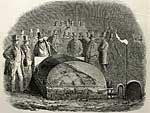 Roast
beef at Castle Yard - 1860s
Roast
beef at Castle Yard - 1860s
It became somewhat fashionable to
roast an ox in the open air during the 1860's and 70's. This roasting
was in the castle yard. The Cathedral Close was also used for such an
event, when an ox was roasted using a newly invented gas spit.
Prince
Albert dies
of typhoid - Flying Post 1861
"December
25 1861
MEETING OF THE
CITIZENS
The
MAYOR presided, and having explained the object of the requisition in
pursuance of which the meeting had been called, said, - The high
character and position of the Prince Consort, the profound grief at his
untimely death, and the deep sympathy felt for Her Majesty so
universally, leaves no doubt on my mind that the proceedings on this
occasion will be such as to maintain the character for loyalty and
devotion to the Sovereign and the Royal Family which has ever
characterised and distinguished this ancient city. - (Cheers.)"
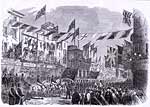 Celebration of marriage of Prince
of Wales
to Princess Alexandra 1863
Celebration of marriage of Prince
of Wales
to Princess Alexandra 1863
From the Flying Post, 11 March - "The
Guildhall soon became the centre of
attraction; and when at ten o'clock the Right Worshipful the Mayor
appeared, accompanied by the High-Sheriff of the city, the
Sergeants-at-Mace, the Sword-bearer with the ancient cap of
maintenance, the Town Clerk, Aldermen, and Councillors, he was greeted
with a hearty and general cheer. The line of the procession was soon
formed. It was preceded by the Artillery Corps band, and proceeded ....
to the Cathedral." Picture from the Illustrated
London News.
Riotous
behaviour
- Flying Post 1867
"ELIZABETH
SMITH, of Topsham, was summoned by P.C. Parker for creating a
disturbance. The officer stated that on Sunday, the 13th inst., he saw
"Lizzie" in a state which plainly proved that she had been indulging
rather too freely in the cup that cheers, but which inebriates. There
was a large concourse of people to listen to her musical voice, which
she was not backward in raising to concert pitch, and to witness her
graceful evolutions. She said she had nothing to say in her defence as
she thought the Bench would not deign to lend a willing ear to her
tale, and would believe the officer in preference to her. She was sent
to prison for seven days, without the option of a fine. The prospect of
a week's incarceration was anything but pleasing to her for indulged in
a rather violent show of grief."
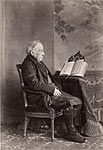 Bishop
Philpotts dies 1868 - Bishop
1831 to 1868
Bishop
Philpotts dies 1868 - Bishop
1831 to 1868
Arguably, the most disliked Bishop ever
appointed to Exeter, the
irascible Phillpotts was accused by Thomas
Latimer of abandoning the
city during the 1832 cholera outbreak. He later took Latimer to court
for libel, after Latimer accused him, in his newspaper, of not telling
the truth regarding
dealings with the Rev. James Shore of Totnes. It is said
that locals would throw rotten fruit at him when he passed in
the street. He was implicated in dealings with the slave trade, through
investments in the West Indies, and he reputedly produced a pamphlet
supporting the massacre of eleven people at the Peterlee Massacre in
1819. He was not a man worthy of his position.
Dr. Frederick Temple was enthroned as Bishop of Exeter on the 30 December 1869. He became the Archbishop of Canterbury in 1896. His son, WIlliam Temple was also Archbishop of Canterbury.
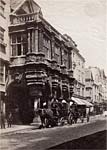 The
Guildhall 1860's
The
Guildhall 1860's
A very early
albumen photograph of the Guildhall is
distinguished by the two
carriages parked outside. The soot on the stone is apparent and the
Guildhall today is much lighter and cleaner.
Harry Hems - Woolmers Exeter
& Plymouth
Gazette 1867
"Henry Hems, a
sculptor, employed at the Museum, was summoned for assaulting Chas.
Lowe. Mr. Floud appeared for the defendant. The complainant said that
about nine o'clock on Tuesday morning he was passing by the Museum when
the defendant abused him, and threw a small stone at him, which struck
him on the forehead. In cross-examination by Mr. Floud, the complainant
admitted that the defendant used to lodge with him. - Richard Ley said
he was passing at the time, and heard the defendant, who was working
with his chisel abusing somebody. He did not see him throw a stone at
anybody. Anyone passing would be liable to be struck by the chips which
fell from the chisel. The Bench considered that there was no evidence
as to throwing the stone, and dismissed the case." See Harry Hems
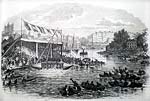 Testing the Exeter Lifeboat 1866
Testing the Exeter Lifeboat 1866
Exeter
had provided a new
lifeboat for Brixham in 1866 when it was paraded
through the streets. Exonians
were fond of their lifeboat, probably because the city still had ships
registered to its port, and occasionally, an Exeter registered ship was
lost at sea.
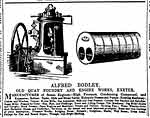 Bodley
and Son advert 1859
Bodley
and Son advert 1859
Possibly the first foundry to open in
Commercial Road, Bodley and Son traded
between 1790 and 1967. The advert from the Flying Post shows they could
manufacture complex steam engines and boilers.
 Flooding at Cowley Bridge 1866
Flooding at Cowley Bridge 1866
This
flood in January 1866 damaged the railway line at Cowley Bridge; Pynes,
the house of Sir Stafford Northcote MP can be seen in the distance. The
Illustrated London News reporter wrote "the marshes on each side of the
Exe, from
Cowley Bridge to St. David's station, were one grand and stormy lake.
Where the hedges had been swept away, they were covered by the waters,
and their locality only known by the elm-trees which towered above the
flood. From Cowley Bridge the lake extended itself upwards over the
River Creedy Vale, as well as up the valley of the Exe."
 Wonford
House 1870
Wonford
House 1870
The Earl of
Devon opened the 120 bed Wonford
House on the 7th July 1869. The new building was large and
airy,
with a grand entrance up a flight of steps. The hospital replaced the
old Bowhay House, but was still only available to those who could
afford to pay for treatment and care. Now named, Exe Vale Hospital, the
extensive grounds also accommodate the main Royal Devon and Exeter
Hospital.
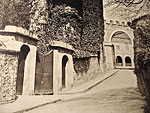 Entrance to Rougemont Castle 1870
Entrance to Rougemont Castle 1870
An
early
albumen print, this time of the entrance to Rougemont Castle and
the
Devon County Court. This entrance is comparatively modern as originally
the castle entrance was over a draw-bridge and through the ivy-covered
entrance tower on the left.
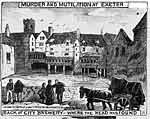 Old Exe Bridge and brewery 1878
Old Exe Bridge and brewery 1878
This
illustration appeared in the Illustrated Police News in 1879 when the
body of a six month baby was found at Powhays Mill.
The head of the
mutilated child was found in the leat at the old Exe Bridge.
Eventually, Annie Tooke,
a child
minder, was arrested and found guilty for the murder. She was
hung in Exeter Prison on the 11 August 1879.
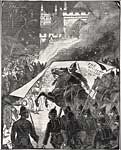
 The Saturnalia Riot 1879
and Guy Fawkes 1882
The Saturnalia Riot 1879
and Guy Fawkes 1882
Every
November 5th 'young
Exeter',
as they were referred to, would assemble in Cathedral Yard to build a
bonfire, which inevitably ended in rioting. In 1879, the Council
boarded up the banks in Cathedral Yard to protect them, but the
inevitable riot broke out. The police were attacked with stones and the
mob tried to break into one of the banks. The Mayor, William Horton
Ellis told the local militia to calm things down, but the rioting
continued. He then entered the yard and read the Riot Act and said "Now, Colonel Drewe, do your duty"
and the men loaded their weapons. The police under Captain Bent, drew
their staves and waded in to the rioters at 1.50am – by 2.10 the
crowd had dispersed. This was the last time a Mayor read the Riot Act.
One of the ringleaders, dressed as a monkey was given six weeks, and
three others were also jailed. Illustration from the Penny Illustrated
Paper. The picture on the right, from the Illustrated London News,
shows the celebration in 1882, and the size of the bonfire in front of
the Cathedral.
 The
Great Exeter Watch Robbery 1880
The
Great Exeter Watch Robbery 1880
An
Exeter
robbery, in 1880, made the Police Illustrated News with their usual
lurid
graphic treatment, on the front page. Moses
Woolf, a wholesale jeweller, was staying in a temperance hotel, with
his stock of 350 watches, 200 rings and
100 chains. Two men at the hotel, who knew of the items, told the night
watch, as they were leaving, that they had an early train
to catch. The watchman (boots in the sketch) thought they were concealing something, so he
quickly dressed and, with a telegraph boy, followed in pursuit. The men
started to run, throwing watches and chains into the road. One man was
caught, and of the £2,000 of stolen stock, he had £1,500 on
his person. On the road '...
they
found a watch, chain or ring
at almost every step.' The men had cut open one bag and
filled
their pockets, and taken a locked case. The
captured man claimed his name was Tanner, a groom from Plymouth, but it
was thought to be a false name.
 Grendon's Almshouses drawn 1879
Grendon's Almshouses drawn 1879
A drawing from the book Old Exeter, by James Crocker, published in
1886. Crocker was an architect who was concerned that many civil and
domestic buildings in Exeter were being demolished without a record
taken of their appearance. Simon Grendon, Mayor in 1395, 1398, 1405 and
1406, founded Grendon's Almshouses, known as the Ten Cells in Preston Street.
By the 19th Century, they were in poor condition, and were demolished
and replaced by Grendon Buildings. New Grendon's Almshouses were built
in Grendon Road, Heavitree.
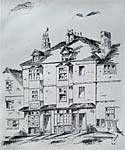 Houses in Coombe Street drawn 1879
Houses in Coombe Street drawn 1879
Another drawing by James Crocker, this time of some old houses in Coombe Street.
According to Crocker they were occupied by a publican and fishmonger.
Whites directory of 1878 indicates a George Lee, a fishmonger and
victualer, occupying premises about half way down on the north side –
by 1897 Kellys indicate that the building was gone.

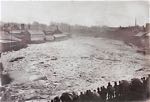 Ice
under the Exe Bridge 1880 New
Ice
under the Exe Bridge 1880 New
The photograph, left, was taken by Charles Keeping. He had several studios in Exeter over the years, but his
principal studio was by the bridge at the bottom of New Bridge Street.
This photograph was probably taken from the studio window during the
winter of 1880. The photo right, is of the 1881 freeze, when a great
snowstorm froze the Exe solid.
When it began to thaw, the water rose and broken pack ice, similar to
the photograph, from up
river, jammed under the Exe Bridge. See Trews
Weir for the full story.
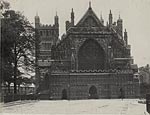 Cathedral
circa 1880
Cathedral
circa 1880
This is a deceiving photograph for it shows a view
of the Cathedral that
does not
seem to have changed at all, and yet is very different from today. The
large elms of Cathedral Green are evident on the left, and the
cast-iron railing that ringed the Green can also be seen. The soot
stained stonework of the Cathedral, was caused by the coal burning
foundries and many domestic coal fires in the city, hiding
the beautiful,
honey coloured stonework.
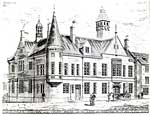 Police Station, Waterbeer Street
1888
Police Station, Waterbeer Street
1888
The
foundation stone was laid on 13 July 1887 by Arthur Burch, the Mayor.
The building was completed in 1888 at a cost of £4,750. The
building had a
distinctive round corner tower with a conical roof. A Roman mosaic
floor of the Prætorium was uncovered and preserved at the foot of
the Court staircase. The mosaic floor was removed to the Royal Albert
Museum when the building was demolished after 1959, only to be thrown
out when a new curator thought it to be Victorian in origin.
 Theatre Royal after the fire 1887
Theatre Royal after the fire 1887
The Theatre Royal fire of 1887 was
devastating for Exeter, as many families mourned the loss of loved
ones. A crowd in New North Road is milling around, as the New London
Inn stables out of the photo, left, were used to lay out the bodies.
The smoke blackened shell of the theatre is apparent.
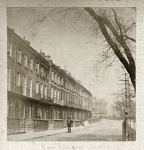 Southernhay West - circa 1890
Southernhay West - circa 1890
Southernhay West was constructed by Matthew Nosworthy in the 1790s. This photo shows the most northern of the four blocks, which was the one that was destroyed in the 1942 bombing. Notice the iron railings around the centre of Southernhay.
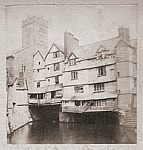 St Edmund's Church and the Lower Leat - circa 1890
St Edmund's Church and the Lower Leat - circa 1890
The photographer was probably standing in front of the Roundtree Mill. The leat flowed under New Bridge Street and split behind the City Brewery – one arm flowed under the Old Exe Bridge, towards the Quay, eventually joining with the Upper Leat near Cricklepit, while an arm flowed into the Exe.
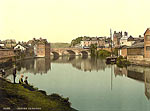 The Exe Bridge 1890
The Exe Bridge 1890
A hand coloured photograph of the River Exe and the old
Georgian Bridge. The photographer stood on Haven Banks and Shilhay is
on the right.
 Albert
Memorial Museum circa 1890
Albert
Memorial Museum circa 1890
The museum opened in 1869 to the
public and soon became an important asset for the city. The Museum
Hotel was situated on the corner of Paul and Queen Street. It
did
not
become the Royal Albert
Memorial Museum until 1899 when the Duke and Duchess of York
(King
George V) visited the institution.
 Paul Collings' business card
Paul Collings' business card
The business card of Paul Collings Junior, who ran the Black
Horse Inn between 1852 and 1891. His Spanish born father, also Paul Collings, arrived
in Exeter as a
young man after serving for the British Army in the Peninsula War and
at Waterloo. Both are buried in St David's Churchyard.
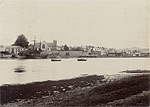 Topsham
1890
Topsham
1890
Topsham had been a
prosperous
port, but by 1860, the
railways had taken much of the trade from the quay. Shipbuilding had
also declined and by 1865 there were no more yards in the town. This
photo shows the quay from the opposite bank of the river Exe in 1890.
Shipping still docked, often to unload into railway trucks, and fishing
was still important, especially for salmon in the estuary and river.
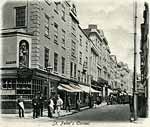
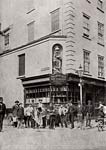 St Peter's Corner, High Street
before 1892
St Peter's Corner, High Street
before 1892
Two views of St Peter's Corner dating from before 1892. The modern Athena on the corner of High and North Street,
occupies the old Hepworth's shop. In 1892, the shop was rebuilt for
Hepworth's and before that date, the shop housed Holman Ham
the
Chemist. When Hepworth's took over the premises, Holman Ham moved to
the corner of High and South Street. The statue
of St Peter is now in the RAMM. The photo left is a postcard, while the image right, is an original photo that may date as early as 1880.
Letter from the
Bishop of Exeter - Flying Post 1891
"My Dear Sirs,I beg to thank you sincerely for
the two
beautiful specimens of the Exeter Art Pottery which you have been kind
enough to send me. The vases will greatly adorn my dining-room, and I
hope that this new artistic industry will take deep root here, and will
employ many cultured designers and skilled workmen in our city.Yours faithfully,E. H. Exon." See Hart and Moist
 Beer and Driffield advert 1894
Beer and Driffield advert 1894
A
city with a Cathedral and a couple of dozen churches is going to be a
ready market for ecclesiastical craftsmen. Beer and Driffield were
based in Bartholomew Street producing and repairing stained glass
windows and church decoration. There are still such craftsmen in Exeter
supplying stained glass for churches and homes.
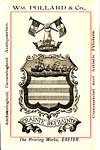 Pollards
the Printers 1894
Pollards
the Printers 1894
William Pollard and
Co., were just over a hundred years old when this advert
appeared
in 1894 in a guidebook. They were then based in North Street but have
since moved three times to their present works in Falcon Road, Sowton.
 Exeter Gas Company advert 1895
Exeter Gas Company advert 1895
The
first illustrated advert I
have found for the Exeter Gas
Company.
They are renting gas stoves, and the busy housewife is depicted
preparing a meal for her family on her newly rented stove. It's a pity
that she looks like one of the witches from MacBeth.
 New
Swimming Baths 1892
New
Swimming Baths 1892
Apart from a small block graphic of a
stagecoach or steamship printed
for an advert, the Flying Post was slow to include pictures on its
pages.
Early attempts were often poor in quality, and it was not until the
1890's that the
paper started to add graphics on a semi regular basis. This example is
of the proposed new
swimming pool at Kings Alley which was built, and
then destroyed in the blitz. It was roughly situated in the Musgrave
Row car
park in front of the Central Library.
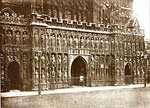
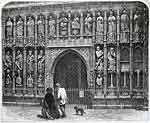 West
Front of the Cathedral 1894
West
Front of the Cathedral 1894
An albumen print of the West
Front of the Cathedral in 1894. There were cast-iron railings along the
front and two gas lights. It had been about 15 years since the last 5th
November bonfire had been built close to the West Front, threatening
the stone with heat damage. The print is from an 1861 issue of the
Illustrated London News, which demonstrates how accurate the
Illustrated London News
engravings could be.
 Victoria's
Diamond Jubilee Arch 1897
Victoria's
Diamond Jubilee Arch 1897
Queen Victoria acceded to the
throne on 20 June 1837. Sixty years later, the people of Exeter
celebrated her Diamond Jubilee by creating decorated arches at
different places in the city. This one, was at the junction of Old
Tiverton Road, Blackboy Road and Sidwell Street. A wood and cardboard
North Gate was also constructed by the City Gate Hotel. Other events
included swimming matches, a Cathedral service, tea and
entertainment for elementary children and a fireworks display in
Belmont Park.
│ Top of Page │